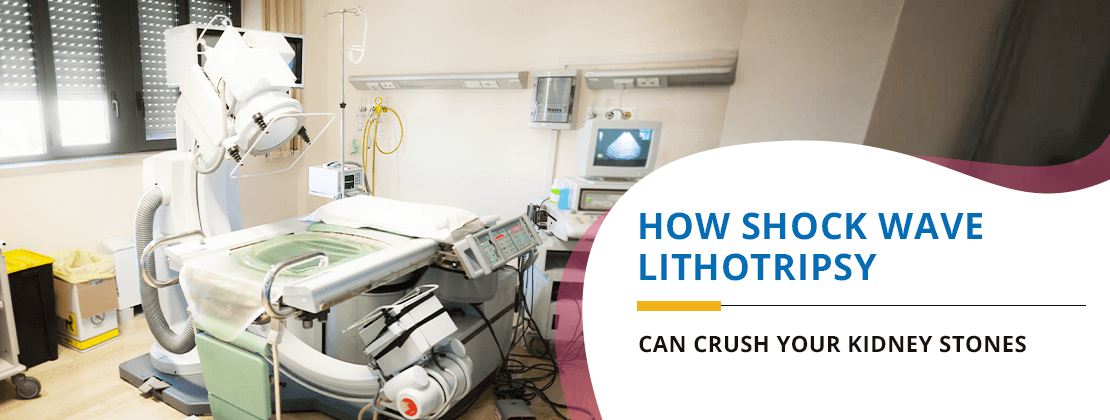
Home / Blog / Shock Wave Lithotripsy for Kidney Stones: Procedure, Benefits & Recovery
Kidney stones are solid formations composed of minerals and salts that develop within the kidneys. Acute pain in the lower back is one of the most noticeable kidney stone symptoms.
Shock Wave Lithotripsy (SWL) works best for small stones (less than 2 cm in diameter) found in the kidney or upper ureter. It utilises a generator to create pressure or shock waves aimed at the stone or calculus.
The waves become kinetic energy when they hit the stone at maximum intensity. The result is the fragmentation of the stone.
As a leading multispeciality hospital in India, HCG Hospitals is known for its exceptional urology care, research, and educational programs and offers the best kidney stone treatment.
At HCG Hospitals, a dedicated team of specialists works together to provide you with high-quality care and facilitate a smooth recovery after the kidney stone medical procedure.
Table of Contents
The following are the different symptoms associated with stone formation in the kidneys:
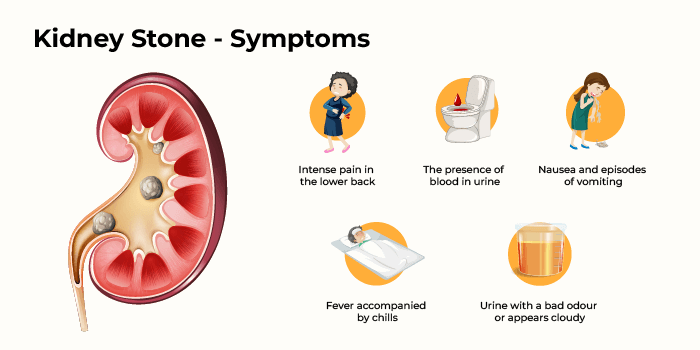
Consult a urologist even as the first signs of kidney stones show up. Early detection and timely treatment are crucial to managing kidney stones effectively.
If you are looking for the best kidney specialist in India, you may reach out to HCG.
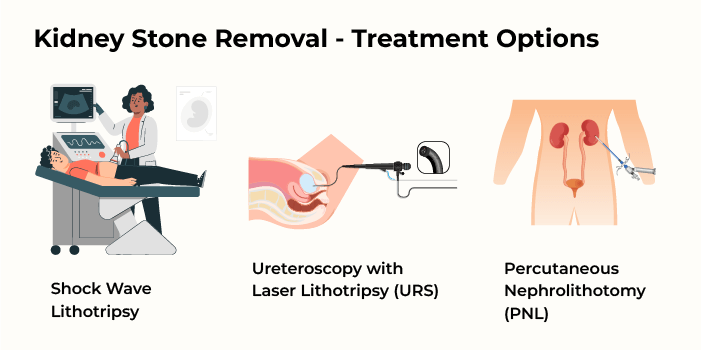
It is a non-invasive procedure for kidney stone removal wherein kidney stones with a size of less than 2 cm are broken down using shock waves.
This is a revolutionary approach that supports faster recovery and has higher success rates.
This procedure is performed to remove stones that are as large as 2 cm, located anywhere in the ureter or kidney.
In ureteroscopy, a mini telescope or ureteroscope is passed into the lower ureter via the bladder. This enables the urologist to inspect the stone and remove it.
Percutaneous nephrolithotomy is now the first-line treatment for removing large kidney stones that are 20 mm or bigger, and it has a great success rate.
Through a small incision in the back, the surgeon lowers a sheath. Then, a nephroscope (a tiny fibreoptic camera) is inserted into the sheath to locate and expel the kidney stone.
If the stone is removed through the sheath, it is called nephrolithotomy. If the stone is crushed and then removed, it is called nephrolithotripsy.
The patient rests on a comfy cushion or a membrane that lets the waves go through. It usually takes around 1,000 to 2,000 shock waves to pulverise the stones. The whole treatment lasts about 45 to 60 minutes.
Shockwave forces break stones through several mechanisms such as cavitation, cleavage, fatigue, shear stress, spall fracturing, squeezing, and superfocusing.
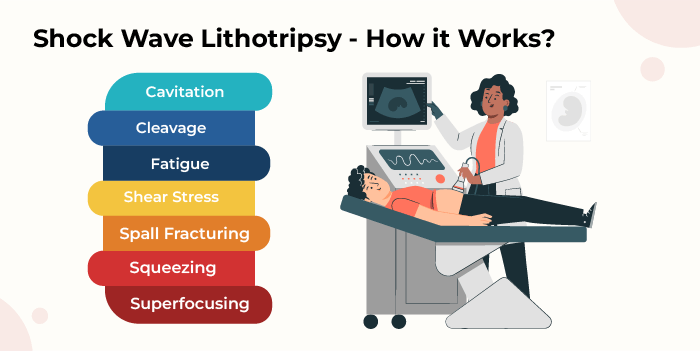
Cavitation: Shockwaves create tiny bubbles around the kidney stone. These bubbles collapse with force, shooting out tiny jets of high-energy fluid that hit the stone and fragment it.
Cleavage: Kidney stones break apart differently depending on the shockwave strength. At high power, the stone splits along the same line as the shockwave. At lower power, the stone disintegrates across the shockwave path.
Fatigue: Kidney stones split easily at weak spots like cracks or corners. The shockwaves hit these spots harder, causing small cracks to grow bigger until the stone splinters.
Shear Stress: Shockwaves create friction inside the kidney stone as it passes through its internal walls and layers. Kidney stones are usually made up of layers that are particularly vulnerable to shear stress pressure, making them easier to fragment.
Spall Fracturing: Shockwaves bounce off the inside of the kidney stone. This bouncing action creates strong pressure points that fracture the stone from inside out and cause it to break.
Squeezing: Shockwaves induce pressure around the kidney stone since they move faster through the stone than the liquid. This pressure tries to break the stone apart.
Superfocusing: Shockwaves can bend inside the kidney stone, creating localised areas of high pressure. This pressure causes microcracks to erupt and fragment the stone.
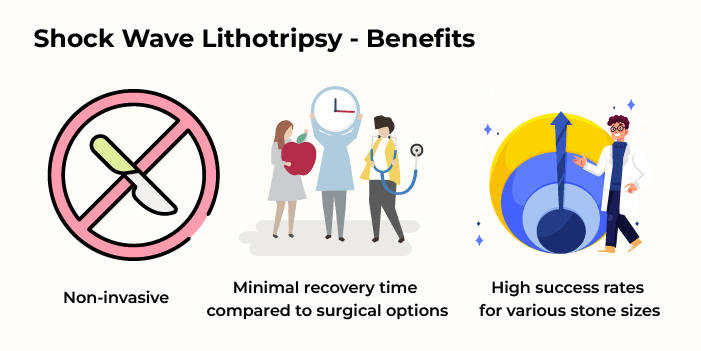
Non-invasive: Shock wave lithotripsy doesn’t involve any cuts on the skin or the use of any invasive tools to remove the stone.
Minimal recovery time compared to surgical options: Once the treatment is over, the patient can start moving around right away. Many can get back to their normal daily routines in just one to two days.
High success rates for various stone sizes: Among patients who undergo SWL, around 70 to 90 percent are typically stone-free within three months after the procedure. Stones of various shapes and sizes, albeit less than 2 cm in diameter, are considered most suitable for SWL.
The healthcare team may adjust your position slightly to align your body with the energy beams. A shock wave lithotripsy device transmits intense energy waves through water and into your body.
During the procedure, if you are awake, you might notice a popping noise or experience a tapping feeling on your side.
You may experience discomfort as particles are expelled shortly after the treatment. Take the prescribed pain medications and stay hydrated to reduce the pain. Some use a heating pad or ice pack on the affected side.
Be up and about. Try to walk as much as possible. It can help push out the fragments. It may take several weeks for your body to completely get rid of the particles.
SWL is not recommended for pregnant women who have kidney stones since the procedure uses X-rays and shock waves.
Individuals with bleeding disorders, infections, significant skeletal deformities, or morbid obesity are not suitable candidates for SWL.
The urology department at HCG Hospitals, a leading urology hospital in India, is fully equipped to treat a spectrum of urologic conditions with the aid of advanced technology and multidisciplinary, state-of-the-art care.
At HCG Hospitals, we employ the modern laser lithotripsy procedure to treat kidney stones. Laser lithotripsy uses laser beams to destroy stones present in the kidneys, ureter, bladder, and urethra.
Our dignified approach to enhancing your quality of life is marked by a personalised care plan.
Our patients’ positive feedback on kidney stone treatment and our success rates reflect the excellence of our healthcare services.
For queries and consultation with a top urologist in India, please contact us at +91 7406499999.